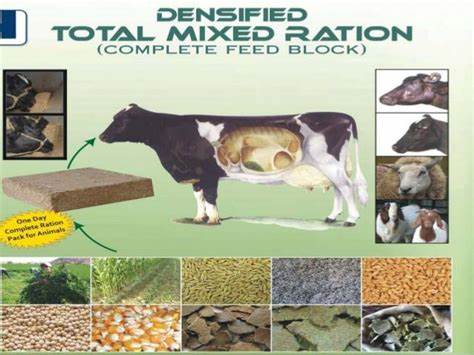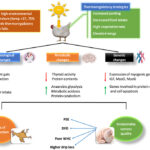
1. Introduction
Total Mixed Ration (TMR) is a feeding method where all the feed ingredients—forages, concentrates, minerals, vitamins, and feed additives—are thoroughly mixed into a homogenous blend. This mixed ration is fed to dairy or beef cattle to provide complete, balanced nutrition in every bite.
TMR is increasingly used in commercial livestock production systems due to its efficiency in improving milk yield, animal health, and feed utilization.
2. Objectives of TMR Feeding
- Deliver a balanced diet with every mouthful to prevent selective feeding.
- Maximize dry matter intake (DMI).
- Improve milk yield and quality.
- Enhance rumen function and microbial efficiency.
- Minimize digestive disturbances (e.g., acidosis, bloat).
- Reduce feed wastage and labor.
3. Components of a Total Mixed Ration
A balanced TMR contains the following components:
| Component | Examples | Function |
|---|---|---|
| Forages | Silage, hay, pasture, crop residues | Source of fiber, maintains rumen health |
| Concentrates | Grains (maize, barley), oilseed cakes | Provide energy and protein |
| Protein sources | Soybean meal, cottonseed meal | Supports growth, milk production |
| Minerals | Dicalcium phosphate, salt mix | Bone health, enzyme functions |
| Vitamins | A, D, E, B-complex | Immunity, reproduction, metabolism |
| Additives | Buffers, probiotics, enzymes, ionophores | Improve digestion and feed efficiency |
| Water | Clean, fresh water always available | Essential for metabolism and milk |
4. Steps in Preparing TMR
- Formulate the ration based on:
- Animal category (e.g., high-yielding lactating cows, dry cows, heifers)
- Nutritional requirements (CP, TDN, minerals, vitamins)
- Locally available feed resources
- Weigh ingredients accurately.
- Chop long-stem forages to 1–3 cm length for uniform mixing.
- Use a feed mixer wagon or machine to blend the ingredients thoroughly.
- Distribute the TMR to feed bunks or troughs—usually twice daily.
5. Nutritional Composition of an Ideal TMR for Dairy Cows
| Nutrient | Requirement (Lactating Cow) |
|---|---|
| Crude Protein (CP) | 16–18% of DM |
| Total Digestible Nutrients (TDN) | 65–72% of DM |
| Net Energy for Lactation (NEL) | 1.6–1.7 Mcal/kg of DM |
| Neutral Detergent Fiber (NDF) | 30–35% of DM |
| Non-Fiber Carbohydrates (NFC) | 35–40% of DM |
| Dry Matter Intake (DMI) | 3–4% of body weight per day |
Note: Adjustments needed based on milk yield, lactation stage, breed, and environment.
6. Types of TMR
- High-forage TMR: Used for dry cows, low-yielding cows, and heifers.
- Balanced TMR: Used for lactating cows—optimized for milk production.
- High-energy TMR: For high-yielding cows in early lactation.
7. Advantages of TMR Feeding
| Benefit | Explanation |
|---|---|
| Balanced nutrient intake | Prevents over- or under-consumption of specific nutrients |
| Reduced feed sorting | Ensures uniform intake of all diet components |
| Improved rumen function | Stable rumen pH due to balanced fiber and starch |
| Higher dry matter intake | Promotes more consistent and higher feed consumption |
| Better milk yield and composition | Enhances milk fat and protein content |
| Labor and time efficient | One-step feeding process reduces manpower requirement |
| Less feed wastage | Properly mixed rations reduce rejection and spoilage |
| Facilitates feed cost control | Allows incorporation of cost-effective byproducts (e.g., molasses, brewery waste) |
8. Challenges and Limitations of TMR
| Challenge | Mitigation Strategy |
|---|---|
| Requires capital investment | Government or NGO support, leasing equipment |
| Needs trained staff | Provide technical training in feed formulation and machine use |
| Improper mixing affects intake | Use calibrated mixers and follow mixing order |
| Heat or moisture damage | Use fresh ingredients, manage storage, use preservatives in silage |
| Not ideal for smallholder farms | Use mini-TMR systems or cooperative mixing units |
9. Monitoring and Management
To ensure the effectiveness of TMR feeding:
- Monitor milk yield and composition regularly.
- Check body condition scores (BCS).
- Observe feeding behavior and bunk cleanliness.
- Adjust formulation as per forage analysis or seasonal variation.
- Regularly service mixers and weighing systems.
10. TMR in Tropical and Subtropical Regions
TMR is adaptable to tropical countries using local ingredients like:
- Silage from sorghum, maize, or Napier grass
- Agro-industrial byproducts: rice bran, cottonseed cake, wheat bran
- Crop residues: treated wheat straw, sugarcane tops
Use of urea-molasses treatment, ensiling, and pelletized feed blocks can help improve feed quality and simplify TMR preparation.
11. Conclusion
TMR feeding is a scientific, efficient, and performance-driven system that enhances productivity in commercial dairy farming. When properly formulated and managed, it supports:
- Optimal animal health
- Higher milk yield
- Better feed efficiency
- Reduced labor costs
Despite its challenges, especially in low-resource settings, TMR can be adapted using local feed resources and cooperative models, making it a transformative tool for modern dairy enterprises.




Reg# 23-CUVAS-0315
0326
23-CUVAS-0318
23-cuvas-0336
23-CUVAS-0312
DVM 4TH
23-CUVAS-0291
23-cuvas-0314
23-cuvas-0322
Abdullah Sharif 23-Cuvas-0332 DVM 4th semester
Reg#:23-CUVAS-0312
DVM 4TH
Laiba Hafeez
Reg no : 23-cuvas-0298
Preetam Raam
23-CUVAS-0334
DVM 4th
23-cuvas-0322
Reg#:23-CUVAS-0312
DVM 4TH
23-cuvas-0291
23-cuvas-0617
Laiba Hafeez
Reg no : 23-cuvas-0298
DVM 4th semester
23-CUVAS-0337
DVM (4th semester)
Waseem saleem
23-cuvas-0321
23-cuvas-0300
23-cuvas-0308
Abdullah Sharif 23-Cuvas-0332
0325
0325